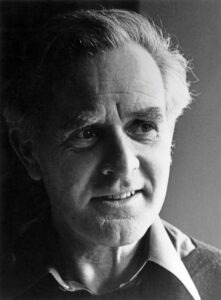Extracted from Creative Writer’s Sourcebook: 50 Great Authors & 175 Writing Exercises by John Gillard, published by Exisle Publishing, RRP: $39.99.
JOHN LE CARRÉ
BORN: October 19, 1931
DIED: December 12, 2020
NATIONALITY: English
KEY WORK: Tinker Tailor Soldier Spy
David John Moore Cornwell was forbidden to publish under his real name by his employers, the British Secret Intelligence Service. He chose the pseudonym John le Carré, and became one of the great writers of the spy novel.
When still an MI6 agent, le Carré wrote both ways on his one-and-a-half-hour commute, at lunchtime, and in the evening. As a full-time novelist he would wake early and work through to lunchtime, enjoying a drink in the evening. He was a great advocate of the power of sleep to allow the unconscious mind to iron out ideas he had been grappling with. He wrote with pen and paper, and could complete a chapter a day. He wrote The Spy Who Came in from the Cold in five weeks.
Composite Characters
Le Carré saw his nine years in the secret service as his ‘little university’ for his future writing. He created his own private world of espionage, filling it with composite characters and abstractions of the world he knew. His main character, George Smiley, was a composite of an Oxford don, himself, and another thriller-writing colleague who also inspired le Carré’s writing career. Alec Leamus, in The Spy Who Came in from the
Cold (1963), was inspired by an Irish stranger le Carré had seen only briefly in a Berlin bar, drinking scotch with a deadness in his eyes. He said he knew then that Leamus would die at the Berlin Wall. His story ideas almost always began with a core character, struggling with internal and external conflict, and a final image. His novels were fluid and spontaneous, allowing the characters to act with authenticity. All roads lead to the final image, like the burning of Panama in The Tailor of Panama (1996), but they take unexpected twists and turns to get there.
Le Carré researched like a journalist looking for a story, notepad in pocket, literally entering the world of his novel. While researching Our Game (1995), he met a Russian mafia boss in a Moscow nightclub, introduced via ex-KGB agents, and surrounded by guards with Kalashnikovs and grenades strapped to their belts. For The Night Manager (1993), le Carré met with arms dealers in Panama, following a recommendation from drug-enforcement officers in Miami. He ended up firing guns on a piece of land on the Costa Rican border. This research trip was for a single passage in the novel. For The Tailor of Panama he went to Panama and looked into the logistics of setting up a tailoring business, tapping up realtors and fabric suppliers.
Tension and Intrigue
Le Carré built tension and intrigue. He used long sentences with little punctuation to create pace, and he balanced this with short, punchy sentences, often using repetition, as in this quote from The Russia House (1989): “She was earnest. She was intelligent. She was determined. She was scared, even though her dark eyes were lit with humour.” Often the pace of the sentence mirrored the action, with no time to worry about correct grammar, as in this example from the same book: “What happened next happened quickly, a street corner transaction, willing seller to willing buyer.” The speed comes through the authorial voice, and so with it, the act of writing itself. This style runs throughout le Carré’s novels with his use of an omniscient narrator.
Le Carré’s prose is to the point yet colorful, with very precise, witty descriptions and lots of metaphors. In the opening lines of his first novel, Call for the Dead (1961), le Carré describes George Smiley in a humorously derogatory way: “…he appeared to spend a lot of money on really bad clothes, which hung about his squat frame like skin on a shrunken toad.” And the descriptions are often unique. Walter in The Russia House is described as a “distraught, floating man.” Le Carré uses these characteristics later on as a plot point. The Americans become suspicious of Walter because of his fragile awkwardness, or “floatiness.” This is classic le Carré cleverness.
JOHN LE CARRÉ EXERCISES
COMPOSITE CHARACTERS
Le Carré drew from people he had encountered throughout his life, primarily from his time working in the Secret Service. He would fuse various elements of their characters and appearance together to form new, often-colorful, and complex characters.
Exercise: Write an outline of a character who might appear in a spy novel using composites of various people you know, or even people you may have encountered very briefly. Jot down a few key characteristics of two or three people, and then write a brief outline fusing elements of each of them into new fictional characters.
REPETITION
In this extract from The Constant Gardener (2001), le Carré used repetition of the word “pain” to create emphasis and a beat in order to make a point:
“Tessa distinguished absolutely between pain observed and pain shared. Pain observed is journalistic pain. It’s diplomatic pain. It’s television pain, over as soon as you switch off your beastly set.”
Exercise: Describe a feeling or concept such as “pain,” “sadness,” or “destruction,” using repetition in order to enhance the point, and to create a compelling beat to the passage.
HUMOROUS CHARACTERISTICS
“When Lady Ann Sercomb married George Smiley towards the end of the war she described him to her astonished Mayfair friends as breathtakingly ordinary.” —Call for the Dead
Exercise: Write down some unusual character descriptions by putting together normally unconnected words or phrases so they jar and are therefore amplified. For example: “breathtakingly ordinary.”
A BRUTAL ASSESSMENT
Le Carré painted a very honest and stark picture of spy characteristics. In The Spy Who Came in from the Cold he was quite brutal:
“What do you think spies are: priests, saints, and martyrs? They’re a squalid procession of vain fools, traitors too, yes; pansies, sadists, and drunkards, people who play cowboys and Indians to brighten their rotten lives.”
Exercise: Write a brutal fictional general assessment of a profession—for example, spies, realtors, bankers, software developers, chefs, accountants, or construction workers.
 TONI MORRISON
TONI MORRISON
BORN: February 18, 1931
DIED: August 5, 2019
NATIONALITY: American
KEY WORKS: The Bluest Eye; Beloved
Toni Morrison was very far from self-reflective. She wanted you to step away from yourself, from what you know, and delve into other realities. She wanted you to let the characters float over you “like ghosts,” and tell you about their lives: giving a voice to the best, the most memorable, of what they have to say.
To Morrison, the protagonists and their stories were already out there. It was a case of being open enough to let them in and hear them. For her, too much toil and endeavor meant the truth would never come. She did, though, accept the pressures of being a writer—that much great writing is still written to a deadline. And so, it is essential to imagine the perfect working environment in which the creative process can flourish unhindered. “What does the ideal room look like? Is there music? Is there silence? Is there chaos outside or is there serenity outside? What do I need in order to release my imagination?” (The Paris Review, 1993)
Poetic and Songful
Morrison was born and raised in Lorain, Ohio. Her parents passed on their love of African-American folktales and spiritual singsongs from a young age, informing much of the subject matter and style of her later work. Morrison’s writing talents trod many paths, from a novel in which the language mirrored the rhythms of jazz music (Jazz, 1992), to a songwriting collaboration with André Previn (“Honey and Rue,” 1992); and from a novel winning the Pulitzer Prize for Fiction (Beloved, 1987), to a children’s book commemorating the Supreme Court’s decision to make racial segregation in public schools unconstitutional (Remember, 2004).
Morrison was always experimental with her work, yet her style always remained poetic and songful in nature. The pain of racial segregation, the legacy of slavery, history, and folklore were never far from her work.
She played with narration, mixing thirdperson omniscient with first-person viewpoints. She played with structure.
Her final novel in the Beloved trilogy (Paradise, 1998) was divided into nine chapters—the first introducing a town, Ruby, the following eight chapters telling the story of eight women central to the town and its local convent.
When it comes to details of her characters Morrison described them in broad strokes, so the reader is left to imagine what they may look like. If a dress is red, it is up to the reader to imagine if it is crimson or claret. The language therefore is often simple and precise yet so flowing it becomes poetic: “A green cross in the field of white slid from brilliant emergency light into shadow” (Paradise).
Filling the Toolbox
When not writing, Morrison described the world around her as chaotic, in confusion, and disordered. When writing she harnessed this chaos in order to piece together a toolbox full of the elements that surrounded her: the people, the weather, the buildings, anything to enliven and enrich the world she was creating. She created order within the chaos.
Morrison never read her work out loud as she wrote. The danger as she saw it was the words might have a certain rhythm and quality of “performance” to them when read aloud. This could give a false impression of the quality of the prose. Prior to dedicating herself fully to writing, Morrison was for many years senior editor of fiction at Random House in New York. She used these editing skills to her advantage within her own work. She did, though, advise against overly revising work. She believed if a paragraph needed to be revised again and again without any clear resolution, then it likely needed to be dropped. She read her work as if she’d never seen it before and critiqued it like an objective editor.
TONI MORRISON EXERCISES
SYMBOLISM: COLORS
Morrison often used symbolism in her work. In Paradise she used color to great effect. The town central to the novel was named Ruby, perhaps a foreshadowing of the bloodshed to come. The color green is used frequently to symbolize the idea of freedom, rebirth, and growth: “Behind a chain-link fence bordered by wide seamless concrete he saw green water.” The green water beyond a fence symbolizes the prospect of freedom.
Exercise: Think of some ideas where you might use color as symbolism. This could be a foreshadowing of something that might happen to a character, revealed within a name, an object, a scenic view. Once you have a few ideas, incorporate this symbolism into a single line or a short paragraph. Perhaps you might like to use color symbolism subtly throughout an entire piece of work?
MULTIPLE NARRATIVES
In her work Morrison often used multiple narratives.
Exercise: Rewrite a scene using one of the characters as the narrator. Repeat with the other two characters. How do their varying voices and viewpoints affect the style and content of the narrative?
REIMAGINING HISTORY
Morrison’s novel Beloved was inspired by a tragic event in the life of Margaret Garner, a true-life historical character. Garner was a slave who fled to freedom in 1856, only to be followed, captured, and taken back into slavery. During her capture she tragically killed her two-year-old daughter so that she would not be forced into a life of slavery. Morrison reimagines the character of the daughter, who becomes central to the plot.
Exercise: Take a true-life historical character and use it to inspire a new story. Research and note down some historical figures and any potential story ideas. Can you reimagine them in some way?
OUTSIDE YOUR EXISTENCE
In an interview with NEA Arts Magazine (2014), Morrison divulged some of the advice she had given students while a lecturer at Princeton University: “Think of somebody you don’t know. What about a Mexican waitress in the Rio Grande who can barely speak English? Or what about a Grande Madame in Paris?”
Exercise: Think of somebody far removed from the world/ community you live in. Imagine a dialogue between them and somebody else within their world. Or write down a number of potential new characters from far and wide as Morrison did above. Roll with it; you may introduce yourself to characters you may never have previously thought about.
 Creative Writer’s Sourcebook: 50 Great Authors & 175 Writing Exercises by John Gillard, published by Exisle Publishing, RRP: $39.99.
Creative Writer’s Sourcebook: 50 Great Authors & 175 Writing Exercises by John Gillard, published by Exisle Publishing, RRP: $39.99.









Join the Discussion
Type out your comment here:
You must be logged in to post a comment.